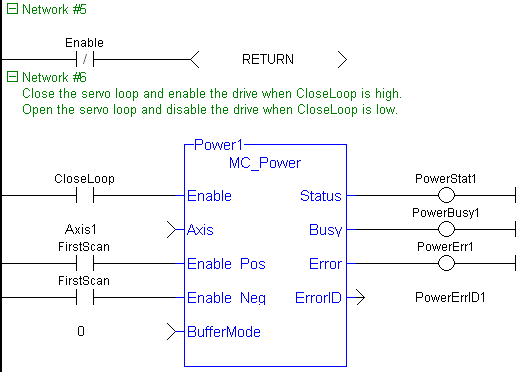RETURN RET RETC RETNC RETCN
Remarks
The "RETURN" statement jumps to the end of the program. In FBD![]() "Function block diagram"
A function block diagram describes a function between input variables and output variables. A function is described as a set of elementary blocks language, the
return statement is represented by the "<RETURN>" symbol. The input of the
symbol must be connected to a valid Boolean signal. The jump is performed only if the
input is TRUE. In FFLD language, the "<RETURN>" symbol is used as a coil at
the end of a rung. The jump is performed only if the rung state is TRUE. In IL
"Function block diagram"
A function block diagram describes a function between input variables and output variables. A function is described as a set of elementary blocks language, the
return statement is represented by the "<RETURN>" symbol. The input of the
symbol must be connected to a valid Boolean signal. The jump is performed only if the
input is TRUE. In FFLD language, the "<RETURN>" symbol is used as a coil at
the end of a rung. The jump is performed only if the rung state is TRUE. In IL![]() "Instruction list"
This is a low-level language and resembles assembly
language, RET, RETC, RETCN and RETNC instructions are used.
"Instruction list"
This is a low-level language and resembles assembly
language, RET, RETC, RETCN and RETNC instructions are used.
When used within an action block of an SFC![]() "Sequential function chart"
It can be used to program processes that can be split into steps.
The main components of SFC are:
- Steps with associated actions
- Transitions with associated logic conditions
- Directed links between steps and transitions step, the RETURN
statement jumps to the end of the action block.
"Sequential function chart"
It can be used to program processes that can be split into steps.
The main components of SFC are:
- Steps with associated actions
- Transitions with associated logic conditions
- Directed links between steps and transitions step, the RETURN
statement jumps to the end of the action block.
ST Language
IF NOT bEnable THEN
RETURN;
END_IF;
(* the rest of the program will not be executed if bEnable is FALSE *)
FBD Language
(* In this example the DTat block will not be called if bIgnore is TRUE *)

FFLD Language
(* In this example all the networks above 5 are skipped if ENABLE is FALSE *)

IL Language
Below is the meaning of possible instructions:
RET Jump to the end always
RETC Jump to the end if the current result is TRUE
RETNC Jump to the end if the current result is FALSE
RETCN Same as RETNC
Start: FFLD IN1
RETC (* Jump to the end if IN1 is TRUE *)
FFLD IN2 (* these instructions are not executed *)
ST Q2 (* if IN1 is TRUE *)
RET (* Jump to the end unconditionally *)
FFLD IN3 (* these instructions are never executed *)
ST Q3
See also






